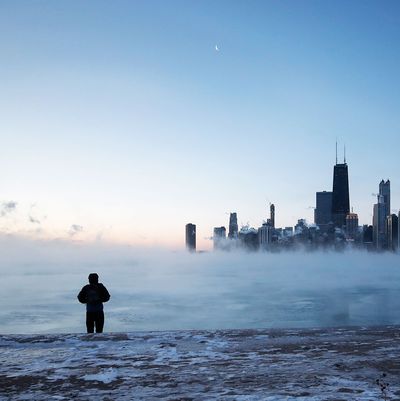
On Wednesday morning, temperatures in parts of the Midwest reached shocking lows — and the polar vortex shows no signs of stopping until at least Friday, the Weather Channel reports. (La Crosse, Wisconsin, charted a temperature of -30 degrees Fahrenheit, while Chicago’s O’Hare Airport registered a -23 degrees Fahrenheit.) Making matters more dire is the windchill currently affecting the area: Parts of Iowa, Minnesota, and North Dakota have all charted windchills of -60 degrees Fahrenheit.
According to the AP, states of emergency have been declared in Illinois, Michigan, and Wisconsin, mail delivery has been halted in some states, and many schools and businesses are closed until the cold subsides. Thousands of people lost power in parts of Illinois; at least six people, including two in the Detroit area, have died as a result of the cold.
In response, people across the region are mobilizing to help those without adequate food, clothing, and shelter. Organizations in major cities are expanding shelter offerings and hours; the New York Times reports that the city of Chicago, where approximately 80,000 people are homeless, has also converted a number of buses into mobile warming stations for those who don’t want to go to shelters for whatever reason. (One man the Times spoke with cited bed bugs, as well as people stealing from one another in shelters, when asked why he did not want to head to a designated shelter.)
On Tuesday, Chicago mayor Rahm Emanuel called the weather “a public health risk,” adding, “You need to treat it appropriately. They are life-threatening conditions and temperatures.”
Homelessness is a year-round epidemic in the United States; a December 2018 report from the Department of Housing and Urban Development noted that a single night in January 2018 saw approximately 553,000 without a place to sleep. John Tribbett, the street outreach manager at St. Stephen’s in Minneapolis, Minnesota, told HuffPost, “We’re dealing with this emergency every day. It’s just the cold weather makes it real for others.”
Donate to a shelter.
Many shelters take cash donations on their websites. St. Stephen’s and YouthLink help people in the Minneapolis area, while organizations like La Casa Norte help people in Chicago. Other organizations, like Chicago’s the Night Ministry, take donations and also provide wish lists for physical goods on their websites; several shelters have also set up Amazon wish lists for their needs. The Chicago Coalition for the Homeless also suggests donating transit cards, as many people may not be able to access transportation to a shelter.
Help someone find shelter.
Warming centers in Chicago have extended their hours to help those in need; the Chicago Coalition for the Homeless notes that two of them will be open for 24 hours. Officials also urge anyone who sees someone outside to call 911. “This is really a historic event in terms of the dangers it presents to people living outside. Every year people lose limbs — ears, toes — to frostbite,” Tribbett explained to HuffPost.
Donate to Native peoples.
According to the AP, many buildings on the Standing Rock Sioux Reservation are in various states of disrepair, or are otherwise ill-equipped to handle temperatures this cold; you can donate to the Standing Rock Sioux tribe via PayPal. The White Earth Band of Ojibwe in Minnesota are also bracing for the cold; energy assistance program manager Chris Fairbanks told the Gazette Times that the vortex was a “scary situation” given peoples’ housing. You can also donate to the White Earth Band of Ojibwe.
Make sure people have enough food.
Because many schools in the Midwest are closed, officials are worried that some children may go without enough food; other people may be unable to find something warm to eat given store closures. You can search for a comprehensive list of food pantries here. You can also make a donation to Gleaners to help people in Detroit, Michigan; the Greater Chicago Food Depository in Chicago, Illinois; or Second Harvest Heartland to help people in Minnesota and parts of Wisconsin.




